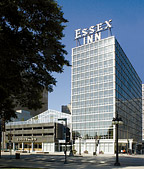Even though the chillers were still going strong, hotel officials were reluctant to gamble on reliability for much longer. "For the hotel business, HVAC system reliability is vitally important," said Steve Tischler, the hotel's chief engineer. "Otherwise, you won't have any guests. If they walk in and the air conditioning isn't working, they'll walk right back out."
With two new McQuay 300-ton dual centrifugal chillers installed in spring 2005, guests continued to be comfortable all summer long, de-spite record-setting heat and humidity. Hotel management saw immediate results, too. During June, the first month of operation, the chillers saved $11,000 in electrical costs - that's an actual savings of 26% and 47% savings over budget.
Two Doing the Work of Four
In a move to reduce heating and cooling costs, Tischler had all of the single-paned windows upgraded three years ago. "The idea worked, to a point, but the hotel's manager wanted more," said Tischler. "It wasn't news to us that we needed to replace our HVAC equipment. But when McQuay's EnergyAnalyzer™ design tools program showed us that the project would pay for itself after just 10 years, we knew we could no longer afford the risk of the chillers breaking down during the heat of the summer, not to mention the cost of the electricity."Tischler also wanted to move away from the old chiller's R-12 refrigerant. The new chillers use R-134a refrigerant.
So far, the centrifugal chillers are the only upgrade to the hotel's centralized HVAC system, although future plans call for a new air handler and new fancoil units in the guest rooms. Still, the new chillers make all the difference, according to Tischler. "Once I turn (the chillers) on, it's noticeable within 30 minutes; you feel it everywhere," he said. "But there's still the same amount of water to cool. The real advantage is that at most two compressors, rather than four, can handle the job."
The old chillers required all four compressors and 570 amps of electricity at startup. The new chillers typically run on two of the four compressors, and at times just one compressor holds the load for the entire building. Even during the hottest days of the summer, two compressors would pull about 38% of their load - about 41 amps - and cool water to 45°F to keep the building's temperature constant. "The hot days started in June and didn't stop until September," said Tischler. "I was there every day, and no matter what the outside temperature, the chillers always ran at 38%."
Prior to the chiller upgrade, the electrical bill for the entire hotel was about $150,000 every six months. After the first cooling season of operation, Tischler said he expects his energy cost savings to be about 40% to 50%. He attributed the impressive results to several factors. First, the new dual centrifugal chiller design is far more advanced than the design of 30 years ago. Second, the chillers are fitted with McQuay MicroTech II® controls, allowing Tischler to regulate just about any variable via a user-friendly touch screen panel. Because the hotel does not have a BAS, the entire chiller plant runs off the digital controls.
Thirdly, the chiller is designed to match the building's load requirements. "We were careful not to under-design or over-design for the load conditions," said Tischler.

A New, Quieter Mechanical Room
In 1972, the old chillers were "kind of shoe-horned into place," said Tischler. Today's building codes required a better fit. Knocking out two walls added space and allowed room to put the MicroTech II controls on their own stands in a separate area.Changing the vessel design of each chiller slightly - shorter length, bigger circumference - gave the extra three feet of space needed to fit both chillers into the room. In addition to the improved design, Tischler is particularly impressed by the chillers' quiet operation. "You can barely hear them running. Now we can talk in the mechanical room. Before, we needed earplugs."ES
